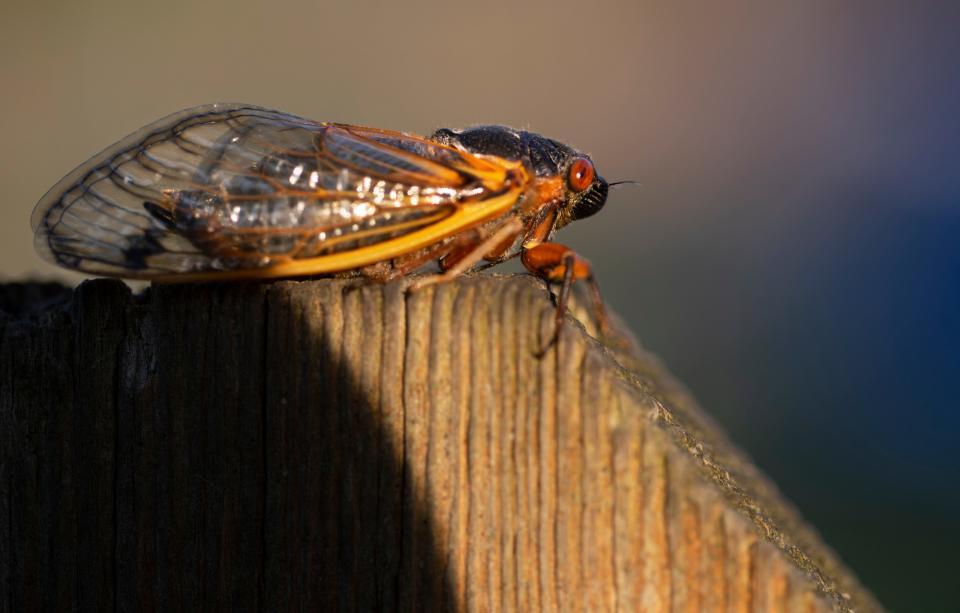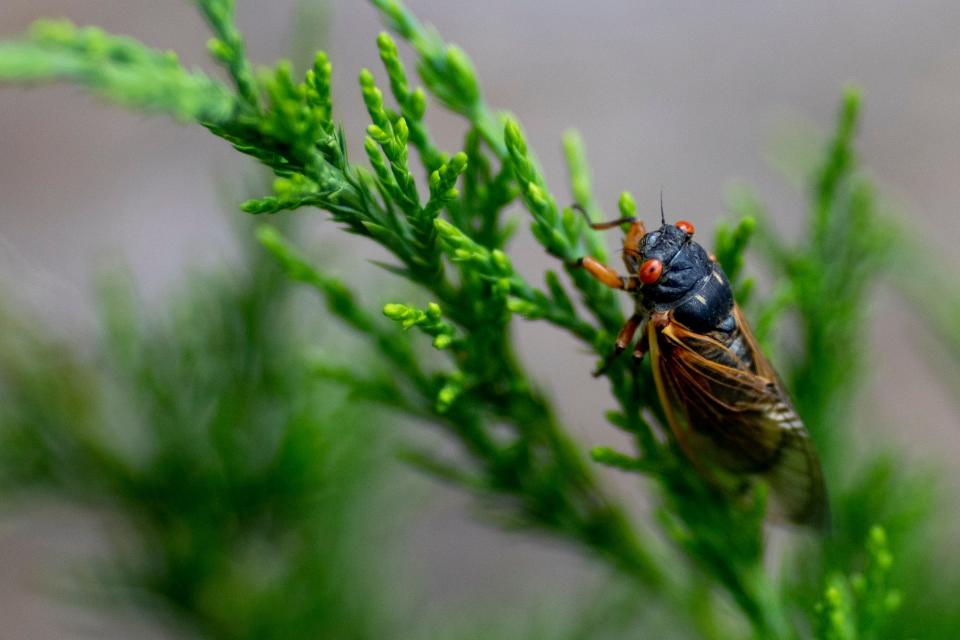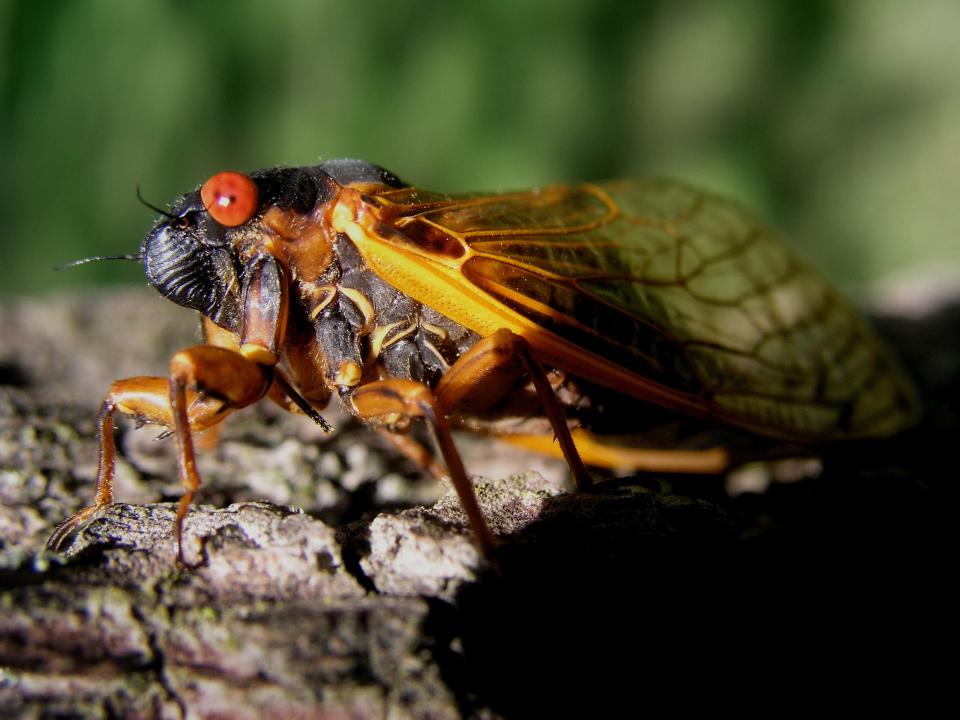Cicadas have existed for more than 5 million years. Now, humans threaten their future.
Periodical cicadas date back to the time when humans split from the apes, according to researchers, making them more than 5 million years old. So it goes without saying that they’ve seen and survived changes to the climate and their habitat.
But what about severe and rapid climate change? Or sweeping and swift development and deforestation?
Researchers are studying these questions in an effort to unlock the mystery that are periodical cicadas. They hope that this year’s emergence of Brood X – one of the largest populations of periodical cicadas expected to appear across 15 states for the first time in 17 years – will provide one more piece to the puzzle.
One thing is clear, however: Humanity poses a threat to these ancient red-eyed bugs, and one of nature’s most dependable delegates. As people have moved in, the cicadas are being forced out.
“Anything that threatens the forest will threaten cicadas,” said Cliff Sadof, a Purdue University researcher who studies cicadas. “That could be climate change. It could be development.”
Either way, they are human-made issues.

Periodical cicadas – some on 13-year cycles and others, such as Brood X, emerging every 17 years – spend the majority of their lives underground sipping the sap of tree roots. This is different from their annual cousins, which are green and a bit smaller, that appear every year or so.
The periodical critters make their aboveground, clockworklike debut for only a few weeks to mate before dying. Things kicked off in Tennessee and Georgia a couple of weeks ago, and they've just recently made their Midwest debut.
Their only evolutionary defense is their numbers: At sometimes more than a million cicadas per acre, predators can’t possibly eat them all, meaning many will survive to reproduce. Still, they don’t stand a chance when the trees they rely on face harsher seasons or a saw blade.
Cicadas: Tens of millions of cicadas are coming to Indiana. Here's how you can help track them.
In just the past century, cicadas have all but disappeared from certain historical breeding grounds as forests made way for development. Other groups of cicadas are emerging years early and without protection in numbers, which many scientists attribute to warmer summers and harsher winters that disrupts the cicadas' sense of timing.
“We have habitat preservation, which is the conservation issue,” Sadof said. “And we’ve got climate change, which is the timing issue.”
The future of periodical cicadas hangs in the balance.
Development drives cicada demise
Even though the various cicada broods populate pockets across nearly one-third of the continental United States, they claimed a far more vast territory before the arrival of European settlers. Hundreds of years ago, almost every acre of land buzzed with the insect’s shrill chirp. Now, many places are silent.
“The range of cicadas that we see now is a fraction of what it would have been, when the Native Americans were the only people around,” said Martin Edwards, a professor of biology at Muhlenberg College in Pennsylvania. “And that was before so many of our forests were cleared for farming and for wood.”
There’s no secret to how that works: If the forests in which the cicadas live are cut down, the cicadas themselves are doomed.
Cicada nymphs are actually busy feeding the whole time they are underground, Edwards said, “they’re not just sleeping or inert.” The roots of trees and plants have fluid flowing through them that cicadas sip out with a straw-like tongue, growing bigger over the years until it’s their time to tunnel out.
“So if the trees are gone,” Edwards said, “there they go, as well.”
But 17 years is a long time, and the world above is less patient.
As trees are felled for roads and buildings, cicadas get trapped underground. That’s what happened in Long Island – once New York State’s last remaining stronghold and the country’s easternmost domain for Brood X. And more than 30 years ago, the island’s air vibrated with the deafening shrill of thousands of chirping cicadas.
However, the population has declined over the decades and had all but vanished during the brood’s most recent 2004 emergence. One Long Island location where the insects once thrived is now silent of cicada chirps. Instead, it is replaced with the hum of car engines and occasional honking horns. That's because it's now a “Walmart with a big parking lot,” Chris Simon, a University of Connecticut professor who has studied cicadas for decades, told The New York Times.
The coming weeks will reveal whether Long Island’s population is still hanging on, but Simon told the Times she worries they are completely gone.
Dipping into dangerous numbers
Such changes are not exclusive to Long Island, Edwards said. He points to other broods that have declined on Long Island as well as in New Jersey and Massachusetts, falling victim to the toll of human activity.
The issue is also a bit more subtle, and even cicadas that live near newly developed areas can suffer, according to John Cooley, an ecology and evolutionary biology professor at the University of Connecticut and a colleague of Simon’s. That’s because cicadas depend on an interconnected network of forests to survive and thrive.
“If there is a break in the network, then cicadas are at risk of dipping below a threshold number,” Cooley said.
They rely on a high density to avoid being eaten by predators. If they don’t have those numbers, then they will be vulnerable to hungry birds, squirrels, dogs and other animals looking for a snack. Cooley said that threshold number is a bit of an unknown, but it’s a question researchers are trying to answer.

He points to Raccoon Grove, an Illinois nature preserve that sits 40 miles southwest of Chicago. The preserve has a history with cicadas: Previous studies at this site served as the origin for estimates that dense areas of cicadas can have as many as one to two million per acre.
Still, several decades later, less than a handful of chirping cicadas could be heard during the most recent emergence. Though Raccoon Grove, as a preserve, is protected, the area around it has been encroached on and developed, Cooley said. Now, the patch is too small and too isolated from nearby wooded areas, and the population has died away.
“In that situation, it wasn’t enough,” he said. “The vast number of cicadas lulls people into a sense of complacency that makes them think the critters are invulnerable. But that’s not the case.”
A matter of timing
When it comes to cicadas, much is still a mystery to scientists. Because the insects emerge only every 17 years, and previous technology was limited in recording their whereabouts – when Edwards last recorded Brood X in 2004, it consisted of driving around a forest with a GPS mapping system and a pencil – data on cicada emergences is spotty.
That said, scientists have recorded climate changes’ impacts on forests and suspect it may be affecting cicadas as well.
For one, the warming world is set to increase the frequency of major storms that, in some cases, can level entire parts of forests. The coming years are also predicted to bring increased flooding, drought and extreme heat, all of which stress trees and may result in habitat loss for cicadas in the long run.
“Climate change," Sadof said, "means climate chaos, basically."
No, they won't bite: Debunking 8 common myths about cicadas and the incoming Brood X
The changes in climate may also impact the times that cicadas emerge.
Scientists believe cicadas measure the seasons through the fluids they drink from trees, and use that to count the number of years before they emerge above ground. If climate change affects the weather enough that those tree fluids appear to signal two seasons instead of one, or skip a season altogether, then those cicadas may emerge at the wrong time.
Sometimes, enough will emerge to create a new brood – but that’s not usually the case.
“Those cicadas, almost all of the time are doomed to failure,” Edwards said, “because their reproductive strategy requires huge numbers.”

Dave Shetlar, professor emeritus at Ohio State University, said a significant shift in climate could also cause cicada broods to shift farther north, as those regions become more temperate. There are very few periodical cicada broods in Canada, he said, but over time, more might extend in that direction. But, he added, “it has to be a real dramatic change” to cause that to happen.
Not only might they shift in region, but in the date of their debut, as well. As temperatures warm from climate change, cicadas may emerge earlier in the year, said Gene Kritsky, dean of the School of Behavioral and Natural Sciences at Mount St. Joseph University in Cincinnati, Ohio.
This year may be an anomaly due to a cold spell delaying the periodical cicada arrival in Ohio and Indiana. Some had even started tunneling to the surface as early as the end of April, Sadof said, before a late spring snow forced them back down. However, in other parts of the country, periodical cicadas have emerged as early as May 16 – almost two weeks earlier compared to when Brood X emerged in 1902, Kritsky said.
It’s worth noting that scientists need more data and research before they can definitively prove any of these potential connections, Edwards said.
“It’s important not to draw a straight line between two things, and call it science,” Edwards said. “That being said, there’s lots of evidence where climate change has had direct effects on forest health, and cicadas are part of that forest health. They’re there; we just can’t see them.”
Long-lasting impacts
Brood X cicadas are aboveground for only, at most, six weeks every 17 years. So what’s the most they can be doing for the environment? A lot, it turns out.
For one, cicadas aren’t just sleeping underground during that period. They’re actually aerating the soil, which helps roots absorb water and nutrients and also reduces runoff. And during the four to six weeks that they emerge, their numbers are a natural feast for wildlife, who see population numbers boost after a summer of cicada munching.
When cicadas die, they’re also a strong fertilizer for the same trees they just spent nearly two decades latched onto. In fact, they increase the nitrogen content in the soil by as much as 200% or 400%, said Robin Ganzert, president and CEO of animal wellbeing organization American Humane.
“As we’re looking at issues of climate change and losing trees and losing so much of nature, this cycle is particularly important,” Ganzert said. “We really are adding nature’s fertilizer to our forest floors and hopefully growing many more trees to again be that counterbalance to climate change.”

Coincidentally, the best way to protect cicadas is also one of the strongest tools for fighting climate change: protecting trees.
Cicadas can’t travel far during their lifetime, only about 50 to 100 meters or so, Sadof said. As such, even if people planted new forests to make up for old ones torn down, the likelihood of a cicada group being able to migrate to different patches of trees in one generation is unlikely. Given that their lifespans are so long, it could take centuries for them to populate a new patch of woods.
“(They’re) just a lot slower,” Sadof said, “so the changes that happen are more long-lasting.”
Brood X: Cicadas are here in Cincinnati. See photos of Brood X
Although the bumbling, winged creatures pop into the public eye only once every other decade, it’s important for humans to understand the impact they’re having on their populations, Edwards said.
After all, a cicada year has long been considered a symbol of nature’s bounty and reminder of the forest’s wellbeing.
“Cicadas are in some ways a long-term barometer of environmental health,” Edwards said. “If we see the cicadas declining, then over time that tells us that something’s wrong. We need to really be paying attention.”
Call IndyStar reporter Sarah Bowman at 317-444-6129 or email at sarah.bowman@indystar.com. Follow her on Twitter and Facebook: @IndyStarSarah.
Contact IndyStar reporter London Gibson at 317-419-1912 or lbgibson@gannett.com. Follow her on Twitter @londongibson.
Contact Columbus Dispatch reporter Beth Burger at 614-461 5178 or bburger@dispatch.com. Follow her on Twitter @ByBethBurger
Connect with IndyStar’s environmental reporters: Join The Scrub on Facebook.
IndyStar's environmental reporting project is made possible through the generous support of the nonprofit Nina Mason Pulliam Charitable Trust.
This article originally appeared on Indianapolis Star: Will cicadas survive threats from climate change and deforestation?

 money
money 